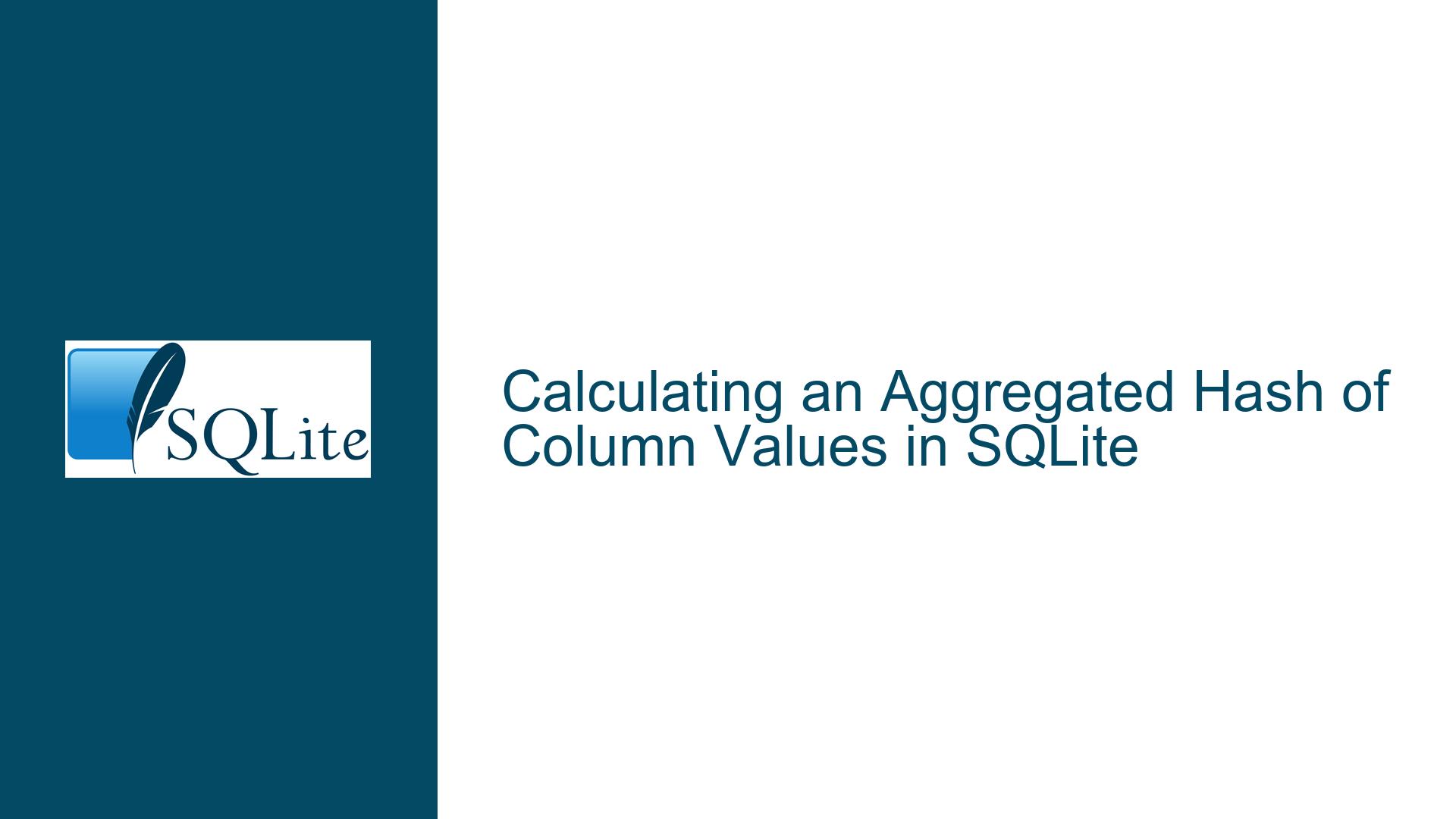Calculating an Aggregated Hash of Column Values in SQLite
Understanding the Need for Aggregated Hashing in SQLite
Aggregated hashing is a technique used to generate a single hash value from multiple input values, typically within a column of a database table. This is particularly useful in scenarios where data integrity needs to be verified, or when a unique fingerprint of a dataset is required. For instance, you might want to ensure that the data in a column has not been tampered with, or you might need a quick way to compare two datasets by comparing their hashes.
In SQLite, the need for aggregated hashing arises when users want to generate a hash value that represents all the values in a specific column. This could be for data validation, change detection, or even for creating a unique identifier for a set of rows. However, SQLite does not natively provide a built-in function for aggregated hashing, which leads users to seek alternative methods or extensions to achieve this functionality.
The discussion highlights the use of the sha3_agg function, which is part of the SQLite CLI shell’s extension functions. This function allows users to generate an aggregated SHA-3 hash of all values in a column. However, the availability of this function is limited to the CLI shell, and it is not part of the core SQLite library. This limitation has led to debates about whether such functionality should be included in the core library or remain as an optional extension.
The Core Issue: Lack of Native Aggregated Hashing in SQLite
The core issue revolves around the absence of native support for aggregated hashing within the SQLite library. While SQLite is renowned for its lightweight and efficient design, it does not include built-in functions for hashing, particularly for aggregated hashing. This omission is intentional, as the SQLite development team prioritizes core database functionality over specialized features like hashing.
The sha3_agg function, which is available in the SQLite CLI shell, is an example of how hashing functionality can be implemented as an extension. However, this approach has its limitations. Users who need aggregated hashing in their applications must either rely on the CLI shell or implement their own custom solutions. This can lead to inconsistencies, increased complexity, and potential performance issues, especially in environments where the CLI shell is not available or practical to use.
Moreover, the discussion reveals a broader debate about the design philosophy of SQLite. Some users argue that hashing should be considered a core functionality, given its importance in data integrity and security. Others contend that SQLite should remain focused on its core database features, leaving specialized functions like hashing to extensions or external libraries. This debate underscores the challenges of balancing functionality with simplicity in database design.
Exploring the sha3_agg Function and Its Limitations
The sha3_agg function is a powerful tool for generating aggregated hashes in SQLite, but it comes with certain limitations. First and foremost, it is only available in the SQLite CLI shell, which means it cannot be used directly in applications that interact with SQLite via its C API or other language bindings. This limitation forces developers to either use the CLI shell for hashing operations or implement their own hashing logic, which can be error-prone and time-consuming.
Another limitation of the sha3_agg function is its reliance on the SHA-3 algorithm. While SHA-3 is a secure and widely-used hashing algorithm, it may not be suitable for all use cases. Some applications may require different hashing algorithms, such as MD5, SHA-1, or even custom algorithms. Since SQLite does not provide a built-in mechanism for selecting different hashing algorithms, users are left to implement their own solutions if they need something other than SHA-3.
Additionally, the sha3_agg function does not provide fine-grained control over the hashing process. For example, it does not allow users to specify the length of the hash output or to include additional data in the hash calculation. This lack of flexibility can be a significant drawback in scenarios where more control over the hashing process is required.
Alternative Approaches to Aggregated Hashing in SQLite
Given the limitations of the sha3_agg function, users may need to explore alternative approaches to achieve aggregated hashing in SQLite. One common approach is to use SQLite’s built-in functions to manually calculate a hash value. For example, users can concatenate the values in a column and then apply a hashing function to the resulting string. While this approach is more labor-intensive, it provides greater flexibility and control over the hashing process.
Another alternative is to use external libraries or extensions that provide hashing functionality. SQLite’s extension mechanism allows users to load external libraries that implement custom functions, including hashing functions. This approach enables users to choose the hashing algorithm that best suits their needs and to use it within their SQL queries. However, it also requires additional setup and maintenance, as users must ensure that the necessary libraries are available and compatible with their SQLite environment.
In some cases, users may opt to implement their own hashing logic directly in their application code. This approach provides the highest level of control and flexibility but also requires significant development effort. Users must carefully design and implement their hashing logic, taking into account factors such as performance, security, and compatibility with other parts of their application.
The Role of Extensions in SQLite’s Ecosystem
The discussion about aggregated hashing in SQLite highlights the broader role of extensions in SQLite’s ecosystem. Extensions are a powerful mechanism for adding functionality to SQLite without bloating the core library. They allow users to customize SQLite to meet their specific needs, whether that involves adding new functions, implementing custom data types, or integrating with external systems.
However, the use of extensions also introduces certain challenges. Extensions must be carefully managed to ensure compatibility with different versions of SQLite and with other extensions. Users must also consider the performance implications of using extensions, as they can introduce additional overhead and complexity. In some cases, the use of extensions may even introduce security vulnerabilities, particularly if they are not properly vetted or maintained.
Despite these challenges, extensions play a crucial role in SQLite’s ecosystem. They enable users to extend SQLite’s functionality in ways that would not be possible with the core library alone. For example, extensions can provide support for advanced data types, such as JSON or geospatial data, or they can integrate SQLite with external systems, such as cloud storage or distributed databases. In the context of aggregated hashing, extensions provide a way to add hashing functionality to SQLite without compromising the simplicity and efficiency of the core library.
Best Practices for Implementing Aggregated Hashing in SQLite
When implementing aggregated hashing in SQLite, it is important to follow best practices to ensure that the solution is efficient, secure, and maintainable. One key best practice is to carefully evaluate the requirements for the hashing operation. This includes considering factors such as the desired hashing algorithm, the size of the dataset, and the performance requirements. By understanding these requirements, users can choose the most appropriate approach for their specific use case.
Another best practice is to leverage SQLite’s built-in functions and features wherever possible. For example, users can use SQLite’s string manipulation functions to concatenate column values before applying a hashing function. This approach can simplify the implementation and reduce the need for custom code. Additionally, users should consider using SQLite’s transaction mechanism to ensure that the hashing operation is performed atomically, particularly in multi-user environments.
Security is another important consideration when implementing aggregated hashing. Users should ensure that the chosen hashing algorithm is secure and appropriate for their use case. For example, SHA-3 is generally considered to be a secure hashing algorithm, but it may not be suitable for all scenarios. Users should also be aware of potential security vulnerabilities, such as hash collisions, and take steps to mitigate these risks.
Finally, users should consider the maintainability of their hashing solution. This includes documenting the implementation, testing it thoroughly, and ensuring that it can be easily updated or replaced if necessary. By following these best practices, users can implement aggregated hashing in SQLite in a way that is efficient, secure, and maintainable.
Conclusion: Balancing Functionality and Simplicity in SQLite
The discussion about aggregated hashing in SQLite highlights the challenges of balancing functionality with simplicity in database design. SQLite’s lightweight and efficient design has made it one of the most widely-used databases in the world, but this design also means that certain features, such as aggregated hashing, are not natively supported. While this can be a limitation for some users, it also reflects SQLite’s commitment to maintaining a simple and efficient core library.
For users who need aggregated hashing in SQLite, there are several options available, including the use of the sha3_agg function in the CLI shell, the implementation of custom hashing logic, and the use of external libraries or extensions. Each of these approaches has its own advantages and disadvantages, and the best choice will depend on the specific requirements of the use case.
Ultimately, the key to successfully implementing aggregated hashing in SQLite is to carefully evaluate the requirements, choose the most appropriate approach, and follow best practices for implementation. By doing so, users can achieve their goals while maintaining the simplicity and efficiency that make SQLite such a powerful and versatile database.






